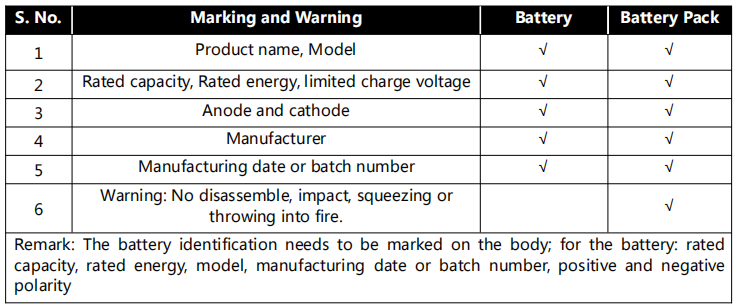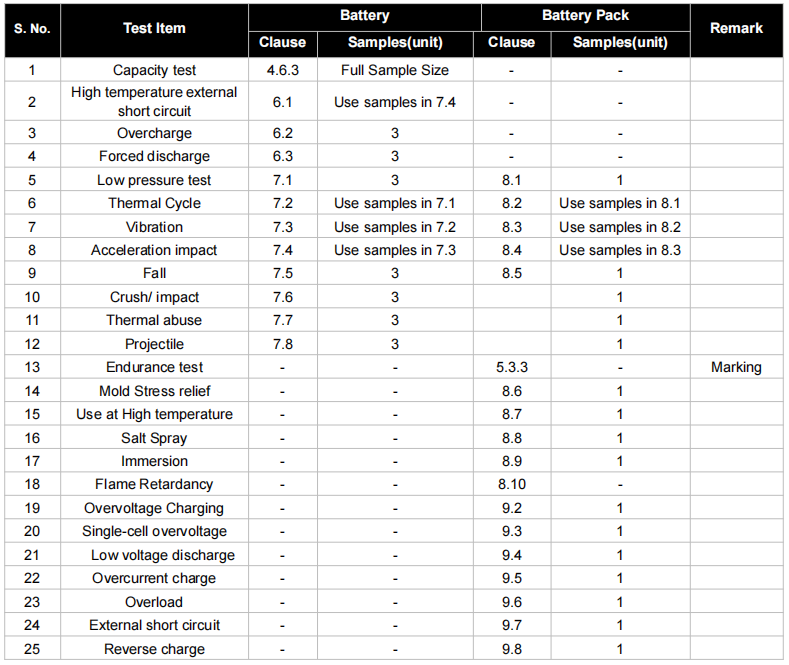Standard Review:
The new standard GB/T 40559:Lithium-ion cells and batteries used in self-balancing vehicle—safety Requirements has been released on the official website of Standardization administration of the P.R.C. in Oct 11th, 2021. This standard will come into effect in May 1st, 2022. This passage is giving a thorough interpretation of the GB/T 40559 for enterprise’s needs in product design and manufacture.
Scope of Standard:
This standard offers regulations on safety requirements of Lithium-ion cells and batteries used in self-balance cars. It is also applicable to the Lithium-ion cells and batteries used in electric skateboard without auto-balance performance.
Requirements
1.Marking and Warning:
2.Safety test for battery
The items need extra attention (See all test items in the following annexed from):
(1)The items with a high probability of test failure are: external short circuit, thermal abuse and projectile, heavy impact (cylindrical battery)
(2)7.6, the batteries applicable to the impact/ squeezing test items are the same as UN38.3: except for the cylindrical battery with a diameter larger than or equal to 18mm for the weight impact test, all other batteries are subjected to the squeeze test.
3.Safety test for Pack
The items need extra attention (See all test items in the following annexed from):
(1)Water immersion test: if the battery can continue to be charged and discharged after the 24h immersion test, a charge and discharge cycle is required. This editor had the experience of electric scooter batteries catching fire during the placement process after soaking in water. The reason is that soaking did not damage the battery, but caused a short circuit. Therefore, similar situations are possible during the test. This needs extra attention.
(2) Flame-retardation requirements: the case, PCB board, and insulating materials have a combustion level of V-1 or higher, and the wire needs to pass the test in appendix C of the standard (needle test).
(3)Single-cell battery overvoltage control: This test requires the addition of voltage monitoring equipment for a cell or parallel block during product design, and the control cell voltage is not greater than 1.05 times the specified upper limit voltage
(4)Reverse charging: this not only requires the product to have a reverse connection protection function, but also adopts a device to avoid reverse polarity connection in the design
4. Other requirements
(1) Key components: It is required to meet the standards mentioned in the corresponding country standard, industry standard;
(2)Safety requirements for high-voltage battery packs: It is recommended that manufacturers avoid using high-voltage battery packs (DC not greater than 60V, AC peak value not greater than 42.4V)
Test Items and samples required
Additional Words
So far, the one that has completed certification documents and test methods for balance bikes is the CESI certification. Because it is a voluntary certification, CESI’s self-developed test standard: CESI/TS 013-2019 has been adopted. So far, consultation and certification have been carried out but the quantity is limited.
The production and sales volume and product types of electric scooters and balance vehicles are increasing year by year, and the demand for the safe use of these products in the industry is increasing. With the release of GB/T 40559, the domestic voluntary certification of lithium batteries for balance vehicles will be promoted.
Post time: Dec-16-2021




